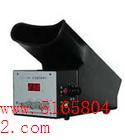
Flash Fusion Frequency Meter / Highlight Scintillator / Model: HA/BD-II-118
When a light flashes at a lower frequency, people tend to perceive it as flickering, which is known as the flicker effect. As the frequency increases, this flickering sensation gradually disappears and the light appears steady—this is called the fusion of light. The lowest frequency at which the flickering stops is referred to as the critical fusion frequency, while the highest frequency at which flickering is still visible is also measured. Together, these values help determine how well a person can detect flashing lights, reflecting their visual acuity in terms of time perception.
The flash fusion frequency meter, often called a bright spot scintillator, is used to measure this critical frequency and assess an individual's ability to distinguish between flickering and steady light. It can also be used to study how factors like color, brightness, background illumination, and contrast affect the critical fusion frequency. These measurements are essential for understanding visual performance and detecting fatigue.
Visual acuity isn't just about seeing clearly—it’s also a key indicator of mental and physical fatigue. People in different states of alertness or tiredness show significant differences in their flash fusion frequencies. Higher frequencies usually indicate better cognitive function, while lower frequencies may suggest fatigue. Because of this, measuring flash fusion frequency is a common method for assessing human fatigue levels, especially in occupational and psychological studies.
This instrument is widely used in psychological experiments and personnel selection. It uses computer-controlled frequency adjustments, ensuring high precision and stability. Its compact and integrated design makes it easy to use and maintain.
Key Technical Specifications:
- Flash frequency range: 4.0–60.0 Hz, adjustable in 0.1 Hz steps using a digital potentiometer; three-digit display with less than 0.1 Hz error
- Highlight colors: red, yellow, green, blue, white (five options); highlight diameter: φ2mm
- Observation distance: approximately 500 mm
- Background light: white, with four intensity settings (1, 1/4, 1/16, and completely black)
- Flash waveform: square wave
- On-off ratio: 1:3, 1:1, 3:1 (three options)
- Highlight intensity: seven levels (1, 1/2, 1/4, 1/8, 1/16, 1/32, 1/64)
- Dimensions: 300 × 150 × 250 mm
- Power supply: AC 220V ± 10%, 50Hz ± 1Hz; relative humidity ≤ 85%
- Power consumption: 5W
Instrument Components:
- The subject’s observation section includes an observation tube, a “frequency adjustment†knob, and a “color selection†knob
- A three-digit display shows the current flashing frequency on the main panel. Below it, there are knobs for adjusting highlight intensity, on-off ratio, and background lighting
Usage Method:
- Turn on the power switch located on the left front of the device. The initial flashing frequency is set to 10.0 Hz.
- Ensure the subject keeps their eyes close to the observation tube and focuses on the central bright spot.
- Select the desired background light intensity, highlight brightness, on-off ratio, and color before proceeding to measure the critical frequency.
- Adjust the frequency using the “Frequency Adjustment†knob on the right side of the instrument. The frequency changes in real-time as you turn the knob, ranging from 4.0 to 60.0 Hz.
- When the subject no longer perceives the flickering, stop the frequency immediately and record the value. If the flicker is initially visible, adjust the frequency until it becomes steady, then record that value. Repeat the test around the fusion point to get an average.
- To test different colors, turn the “Color Select†knob to choose the desired color.
- To evaluate the effect of varying brightness, keep other conditions constant and measure the critical frequency at different intensities.
Precautions:
- If the display doesn’t work after turning on the power, check the power plug, cable, fuse, switch, and +5V power supply first.
- Place the instrument in a dry and well-ventilated area.
- If not in use for long periods, power it on for more than 4 hours every three months. In high humidity environments, power it on monthly for at least 4 hours to prevent damage.
Luxury Hotel Furniture,Wooden Hotel Furniture,Hotel Style Bed Frame,Wooden 5 Star Hotel Furniture
PinSheng hotel furniture , https://www.pinshotelfurniture.com